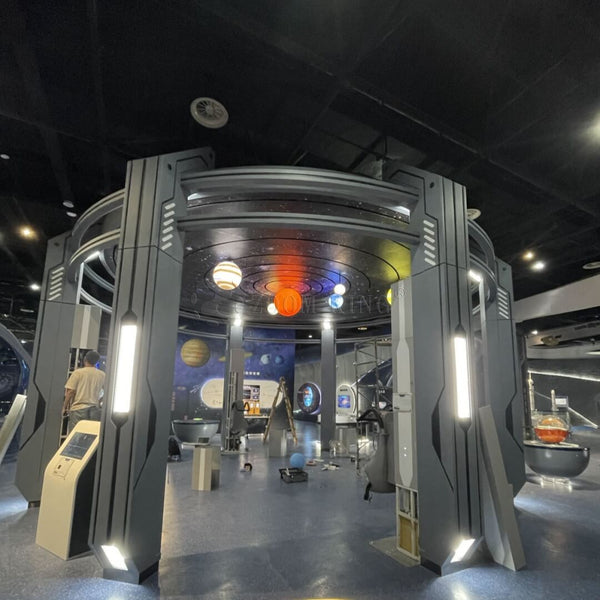Journey Through the Solar System: An 8-Meter Interactive Planetary Orbit Exhibit

Introduction
Step into the cosmos with one of the most awe-inspiring astronomy exhibits ever designed — a colossal, 8-meter-diameter interactive model of the eight planets in our solar system. Standing nearly 6 meters tall, this immersive installation simulates the orbital motion of the planets around the Sun, helping visitors of all ages visualize and understand the mechanics of our celestial neighborhood. Designed for interactive science museums and planetariums, this exhibit transforms space education into a truly unforgettable journey.
Bringing the Solar System to Life
While most solar system models are static and small-scale, this exhibit redefines space education by adding real-time motion, scale perception, and artistic design. Each of the eight planets — Mercury, Venus, Earth, Mars, Jupiter, Saturn, Uranus, and Neptune — moves along independent elliptical tracks, mimicking their true orbits.
Key Features:
-
Massive Scale: With a diameter of 8 meters and height close to 6 meters, the structure gives visitors a physical sense of the solar system’s grandeur.
-
Realistic Orbital Paths: The planetary models rotate and revolve, each at its own speed and distance, mimicking the natural celestial mechanics.
-
Central Sun Display: A glowing central sphere represents the Sun, enhanced by lighting and visual effects to simulate solar energy and gravitational influence.
-
Time Simulation Mode: Educators can accelerate or slow down planetary motion to demonstrate orbital periods and relative distances.
-
Interactive Console: Visitors can control the speed, observe eclipses, or initiate a planetary alignment simulation.
Educational Value
This planetary exhibit is more than just visually stunning — it is an immersive learning tool that supports core STEM education goals and astronomy curricula.
-
Visualizing Orbital Mechanics: Understand how each planet moves in relation to others and how distances and sizes vary across the solar system.
-
Relative Scale Demonstration: Helps clarify the vast differences in planetary orbits, size, and revolution periods.
-
Understanding Celestial Patterns: Observe and predict planetary alignment, retrograde motion, and eclipse phenomena.
-
Promotes Inquiry-Based Learning: Visitors are encouraged to ask questions like: Why does Mercury orbit faster? Why are gas giants so far from the Sun?
Why Visitors Love It
-
🌍 Immersive Experience: Standing under moving planets gives visitors a cosmic perspective that flat images and videos can’t offer.
-
🚀 Great for All Ages: Whether it’s a curious child, a high school student, or an astronomy enthusiast, the exhibit provides layered learning opportunities.
-
📷 Photo-Friendly & Inspiring: Its massive scale and moving planets make it a visitor favorite for photos and social sharing.
-
💡 Perfect for Guided Learning: Facilitators and science educators can use this exhibit as the center for live demos and lectures.
Behind the Innovation
This complex kinetic structure is the result of months of development by a cross-disciplinary team of mechanical engineers, designers, and astronomy educators. The challenges included:
-
Synchronizing planetary movements
-
Building large-scale tracks with precision
-
Ensuring smooth, quiet, and safe operation in public spaces
-
Creating weather-resistant and museum-grade materials
Every detail — from planetary color to orbital tilt — has been designed with scientific accuracy and visual impact in mind.
Conclusion
The Eight-Planet Orbit Exhibit is a landmark in interactive space education. By combining monumental scale with precise mechanics and artistic presentation, it opens a new window into the solar system for curious minds of all ages. Whether you're exploring the planets for the first time or teaching complex orbital dynamics, this exhibit makes the mysteries of space come alive.
